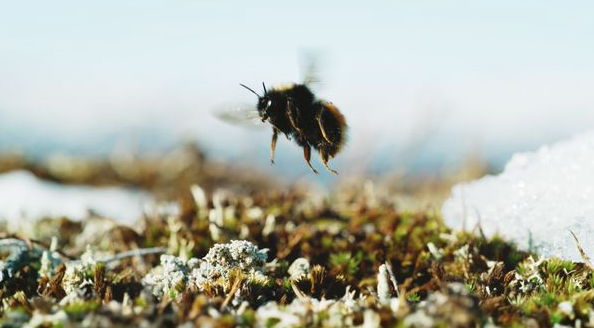The secret life of bees
20 May, 2023 science
When I think of bees, I picture a big, fuzzy bumblebee, lolling gently between flowers, or perhaps a honeybee, collecting as much pollen as possible. Maybe even a solitary bee, looking for a hole in which to build a home. The one thing these images all have in common (at least for me!) is that they all happen on a warm, sunny day. We don’t typically think of bees living in the cold and unforgiving Arctic!
20 May marks UN World Bee Day – an international campaign to raise awareness of the plight of pollinators, and how they contribute to a sustainable planet. This year, we wanted to bring your focus to the incredible Lapland bumblebee…
Researchers, including from British Antarctic Survey, joined forces with BBC Frozen Planet II to make new discoveries about the nesting behaviour of the Lapland bumblebee (Bombus lapponicus).
As part of the episode Frozen Lands, which explored extreme life in our planet’s northernmost latitudes, the team headed to Arctic Sweden to film the unseen story of the Lapland bumblebee queen building a nest and raising a family. As well as being the first time anyone had filmed this amazing story, the collaboration also resulted in new observations of the nesting behaviour of this Arctic species.

The filming took place in Abisko, Arctic Sweden, where the team scoured the landscape in search of a queen bee. They discovered one foraging on flowers, and carefully observed her flight path to locate the nest which was hidden in shallow soil, 10cm underground, inside an old lemming burrow.
The team spent a day observing the queen’s activities to understand more about how much time she spent collecting food and inside the nest caring for the eggs. The researchers then carefully excavated the nest and transported to a laboratory rearing chamber where the researchers observed the bee’s behaviour, and the development of her eggs.
The team used a specialised low-light camera to film inside the pitch-black nest. The team discovered that the queen bee actively incubated her eggs, covering the brood with her body and vibrating her flight muscles to keep them warm. The nest also included a large tubular honey pot that had not been seen before in other bumblebee species.
The researchers hope that the resulting scientific paper on the nesting behaviour of the most commons Arctic bumblebee species could help us understand the ecology and behaviour of other bumblebee species living in tundra environments.
Prem Gill, a PhD student at British Antarctic Survey, who was a researcher for the episode says:
“The Arctic tundra is a land of extremes with 24 hours of sunlight in summer, and temperatures plummeting to -50˚C in the winter. Very few animals can survive here year-round – in fact, only around half of all Lapland bumblebee queens make it to the next winter. It was special to watch the fascinating story of these bees play out – this was actually a story Sir David Attenborough himself picked out as one of his favourites from the series!”
Episode 5: Frozen Lands of Frozen Planet II is currently available on BBC iPlayer.